你还在用B端大模型?OUT 了!!!用混元打造专属智能化桌面应用
原创你还在用B端大模型?OUT 了!!!用混元打造专属智能化桌面应用
原创
不惑
修改于 2024-10-24 09:13:55
修改于 2024-10-24 09:13:55
引言
人工智能的迅猛发展,基于大模型的技术已经渗透到各个行业。腾讯云推出的混元大模型在大模型领域中的表现可谓出色。同时,JavaFX 作为 Java 生态系统中功能强大的 UI 框架之一,凭借其丰富的组件和灵活的布局能力,逐渐成为构建桌面应用的首选工具。
本篇文章将详细讨论如何将 JavaFX 与混元大模型结合起来,构建一个智能化的桌面应用,用户可以通过该应用实时与混元大模型进行交互,实现类似智能对话的功能。我们将从技术选型、前后端集成、具体实现步骤等方面进行深入探讨。
先上结果:
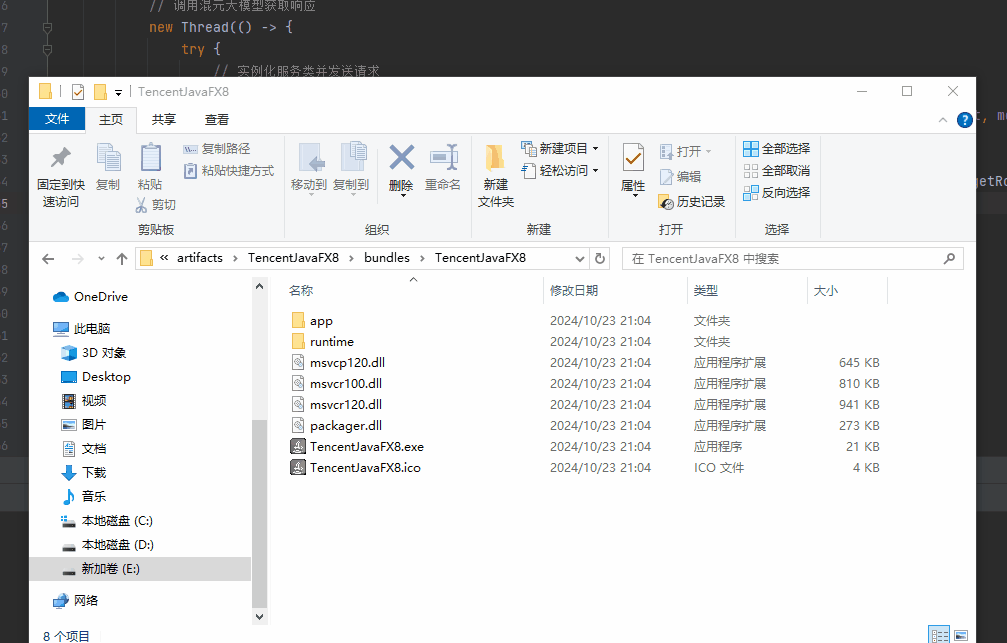
技术选型与整体架构
JavaFX 简介
JavaFX 是一个现代化的 UI 框架,允许开发者创建跨平台的桌面应用。与传统的 Swing 或 AWT 相比,JavaFX 提供了更强大的图形渲染能力、响应式布局设计,并支持使用 FXML 和 CSS 来定义界面结构与样式,使得 UI 开发更加灵活。
- 强大的图形支持:可以轻松实现复杂的动画和图形效果。
- 组件丰富:提供丰富的 UI 组件,如按钮、表格、列表等,支持高自定义化的界面开发。
- 跨平台:编写一次代码,能够在 Windows、Mac 和 Linux 上运行。
混元大模型简介
腾讯混元大模型是腾讯自主研发的通用大语言模型,具备强大的中文创作能力、复杂语境下的逻辑推理能力,以及可靠的任务执行能力。大模型采用了全新的DiT架构(Diffusion With Transformer),这是基于Transformer架构的扩散模型,混元大模型基于深度学习和大规模数据训练,具有强大的内容生成和理解能力。其技术原理包括深度学习、自然语言处理、注意力机制、知识图谱、大规模预训练、微调与优化等多个方面。
- 多轮对话
- 具备上下文理解和长文记忆能力,流畅完成各专业领域的多轮问答。
- 内容创作
- 支持文学创作、文本摘要、角色扮演能力,生成流畅、规范、中立、客观的文本内容。
- 逻辑推理
- 准确理解用户意图,基于输入数据或信息进行推理、分析。
- 多模态支持
- 支持文字生成图像能力,输入指令即可将奇思妙想变成图画
通过调用混元大模型的 API,开发者能够将自然语言处理能力无缝集成到自己的应用中,从而实现智能化的交互体验。

架构设计
为了实现一个智能化的桌面应用,我们可以采用以下架构:
- 前端:JavaFX
JavaFX 提供用户界面,允许用户输入文本消息,并展示与混元大模型的对话内容。前端通过 FXML 定义界面布局,使用 CSS 控制样式,确保用户体验流畅。
- 后端:混元大模型 API
通过混元大模型 API 接收用户输入,生成符合语境的响应内容,并将结果返回给前端。
集成方式:
- 通过 Java 的
HttpClient库调用混元大模型 API,进行异步请求处理。JavaFX 负责界面呈现,HttpClient 负责后端通信,最终实现前后端联动。
开发环境配置
安装和配置 JavaFX
在这里提一下,Java 8 中内置了JavaFX,但是从Java 9开始 JavaFX 不再包含在 JDK 中,而是作为一个独立的模块提供。
如果大家使用JDK 11 使用 Maven 或 Gradle 来管理项目,可以通过以下依赖导入 JavaFX
Maven 依赖
<dependencies>
<dependency>
<groupId>org.openjfx</groupId>
<artifactId>javafx-controls</artifactId>
<version>17.0.1</version>
</dependency>
<dependency>
<groupId>org.openjfx</groupId>
<artifactId>javafx-fxml</artifactId>
<version>17.0.1</version>
</dependency>
</dependencies>配置混元大模型 API
要使用腾讯云混元大模型,首先需要在腾讯云控制台获取 API Key 和 Secret。接下来,设置以下必要的参数:
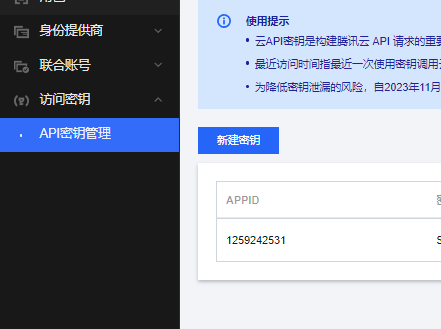
- Endpoint:API 请求地址。
- API Key:在腾讯云申请到的 API 密钥。
- Request Body:用户输入的文本消息,将其传递给混元大模型生成响应。
- 使用
HttpClient进行网络请求,并解析返回的 JSON 数据。
JavaFX 前端开发
FXML 文件构建界面
FXML 是 JavaFX 中用于定义 UI 布局的 XML 格式文件。我们可以使用 FXML 来构建一个基本的聊天界面,允许用户输入并发送消息。
<?xml version="1.0" encoding="UTF-8"?>
<?import javafx.geometry.Insets?>
<?import javafx.scene.control.Button?>
<?import javafx.scene.control.ScrollPane?>
<?import javafx.scene.control.TextField?>
<?import javafx.scene.layout.*?>
<VBox xmlns="http://javafx.com/javafx/11.0.1" xmlns:fx="http://javafx.com/fxml/1"
fx:controller="com.demo.fx.controller.ChatController" spacing="10" stylesheets="/chat.css">
<padding>
<Insets top="10" right="10" bottom="10" left="10" />
</padding>
<children>
<!-- 聊天消息显示区域 -->
<ScrollPane fx:id="chatScrollPane" fitToWidth="true" VBox.vgrow="ALWAYS">
<content>
<VBox fx:id="chatBox" spacing="10" />
</content>
</ScrollPane>
<!-- 用户输入区域 -->
<HBox spacing="10">
<TextField fx:id="userInput" HBox.hgrow="ALWAYS" onAction="#handleSendMessage" />
<Button text="发送" onAction="#handleSendMessage" />
</HBox>
</children>
</VBox>JavaFX 控制器类
控制器类是处理界面逻辑的地方。我们在 ChatController 中处理用户输入,并调用混元大模型 API 获取响应,之后将响应结果更新到 UI。
package com.demo.fx.controller;
import com.tencentcloudapi.common.exception.TencentCloudSDKException;
import com.tencentcloudapi.hunyuan.v20230901.models.ChatCompletionsResponse;
import com.tencentcloudapi.hunyuan.v20230901.models.Message;
import javafx.application.Platform;
import javafx.fxml.FXML;
import javafx.scene.control.Label;
import javafx.scene.control.ScrollPane;
import javafx.scene.control.TextField;
import javafx.scene.layout.VBox;
public class ChatController {
// 共通参数
private String secretId = "AKIDmuwoZ8YllZDj2EGBuRxGSccRAg4HGVfe";
private String secretKey = "rVyJSN9qZFrJdomgT4aDj5GMPGtaHm3M";
private String region = "ap-beijing";
private String endpoint = "hunyuan.tencentcloudapi.com";
private String model = "hunyuan-pro";
@FXML
private ScrollPane chatScrollPane;
@FXML
private VBox chatBox;
@FXML
private TextField userInput;
// 处理发送消息的动作
@FXML
private void handleSendMessage() throws TencentCloudSDKException {
String message = userInput.getText();
if (!message.trim().isEmpty()) {
addMessage("user", message); // 假设所有消息都是用户发送的
userInput.clear(); // 清空输入框
// 这里可以添加代码来处理AI的响应,并调用addMessage("ai", aiResponse);
// 创建消息对象
Message[] messages = new Message[1];
Message content = new Message();
content.setRole("user");
content.setContent(message);
messages[0] = content;
// 调用混元大模型获取响应
new Thread(() -> {
try {
// 实例化服务类并发送请求
TencentCloudService service = new TencentCloudService();
ChatCompletionsResponse response = service.sendChatMessage(secretId, secretKey, region, endpoint, model, messages);
Label messageLabel = new Label(response.getChoices()[0].getMessage().getContent());
messageLabel.getStyleClass().addAll("message", response.getChoices()[0].getMessage().getRole() + "-message"); // 应用通用样式和特定发送者样式
// 更新UI必须在JavaFX应用主线程中进行
Platform.runLater(() -> chatBox.getChildren().add(messageLabel)); // 将消息添加到VBox容器中
} catch (Exception e) {
e.printStackTrace();
}
}).start();
}
}
}样式优化(CSS)
为消息气泡增加样式,可以增强用户体验,提供清晰的视觉区分。
/* chat.css */
/* 设置整个VBox的背景颜色和内边距 */
.root {
-fx-background-color: #f4f4f4;
-fx-padding: 10;
}
/* 设置聊天消息显示区域的样式 */
#chatScrollPane {
-fx-background-color: white;
-fx-border-color: #cccccc;
-fx-border-width: 1px;
}
/* 设置聊天消息区域的样式 */
#chatBox {
-fx-background-color: white;
}
/* 设置用户输入区域的样式 */
#userInput {
-fx-background-color: #ffffff;
-fx-border-color: #cccccc;
-fx-border-width: 1px;
-fx-border-radius: 5px;
-fx-padding: 5px;
}
/* 设置发送按钮的样式 */
#userInput > .button {
-fx-background-color: #007acc;
-fx-text-fill: white;
-fx-border-radius: 5px;
-fx-padding: 5px 10px;
}
/* 设置按钮悬停时的样式 */
#userInput > .button:hover {
-fx-background-color: #005fa3;
}
/* 设置聊天消息显示区域的样式 */
#chatScrollPane {
-fx-background-color: #f4f4f4; /* 浅灰色背景 */
-fx-border-color: transparent; /* 透明边框 */
-fx-border-width: 0;
-fx-background-radius: 5px; /* 圆角 */
-fx-padding: 10; /* 内边距 */
}
/* 设置聊天消息区域的样式 */
#chatBox {
-fx-background-color: transparent; /* 透明背景 */
-fx-spacing: 10; /* 消息之间的间距 */
}
/* 设置单条消息的样式 */
.message {
-fx-background-color: white; /* 消息背景色 */
-fx-border-color: #e0e0e0; /* 边框颜色 */
-fx-border-width: 1px; /* 边框宽度 */
-fx-border-radius: 10px; /* 圆角 */
-fx-padding: 10; /* 内边距 */
/* -fx-max-width: 60%; *//* 最大宽度 */
-fx-alignment: top-left; /* 文本对齐方式 */
}
/* 设置用户发送的消息样式 */
.user-message {
-fx-background-color: #dcf8c6; /* 用户消息背景色 */
-fx-border-color: #a9d58e; /* 用户消息边框颜色 */
-fx-alignment: top-right; /* 用户消息文本对齐方式 */
}
/* 设置AI发送的消息样式 */
.ai-message {
-fx-background-color: #e6f7ff; /* AI消息背景色 */
-fx-border-color: #b3d1ff; /* AI消息边框颜色 */
-fx-alignment: top-left; /* AI消息文本对齐方式 */
}
/* 设置单条消息的通用样式 */
.message {
-fx-font-family: 'Arial', sans-serif; /* 字体 */
-fx-font-size: 14px; /* 字体大小 */
-fx-text-fill: #333333; /* 文本颜色 */
-fx-background-color: #ffffff; /* 消息背景色 */
-fx-border-color: #e0e0e0; /* 边框颜色 */
-fx-border-width: 1px; /* 边框宽度 */
-fx-border-radius: 10px; /* 圆角 */
-fx-padding: 10; /* 内边距 */
/* -fx-max-width: 60%; *//* 最大宽度 */
-fx-alignment: top-left; /* 文本对齐方式 */
}
/* 设置用户发送的消息样式 */
.user-message {
-fx-background-color: #dcf8c6; /* 用户消息背景色 */
-fx-border-color: #a9d58e; /* 用户消息边框颜色 */
-fx-alignment: top-right; /* 用户消息文本对齐方式 */
}
/* 设置AI发送的消息样式 */
.ai-message {
-fx-background-color: #e6f7ff; /* AI消息背景色 */
-fx-border-color: #b3d1ff; /* AI消息边框颜色 */
-fx-alignment: top-left; /* AI消息文本对齐方式 */
}看下运行效果:
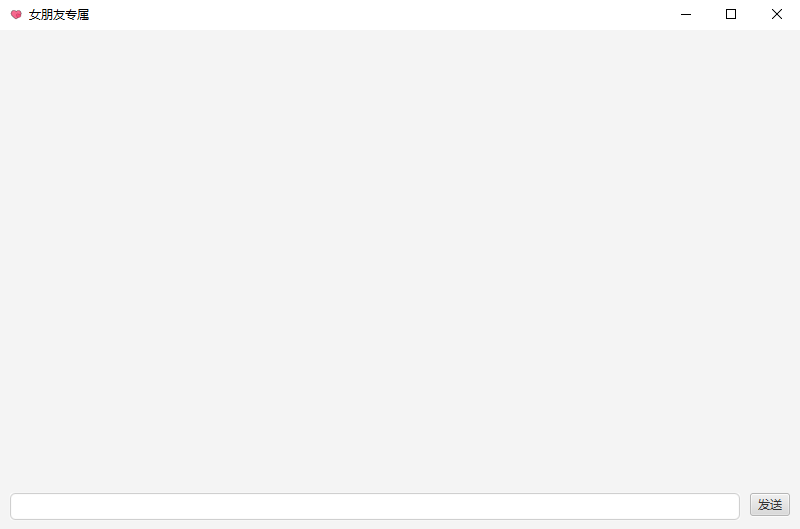
混元大模型 API 集成
配置 HunyuanClient
为了与混元大模型交互,需要使用腾讯云提供的 HunyuanClient SDK 或者直接通过 HTTP API 请求。我们可以使用 Java 的 HttpClient 来实现与混元大模型的通信。
Maven引入
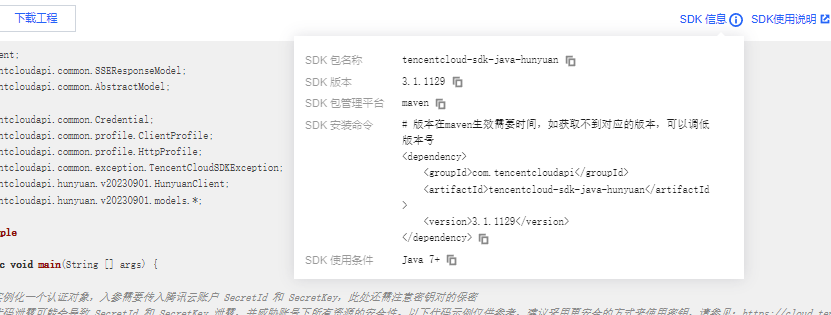
发送请求
下面是一个简单的通过 HTTP 请求调用混元大模型的示例。可以使用此代码将用户输入发送到混元大模型,并接收智能回应:
package com.demo.fx.controller;
import com.tencentcloudapi.common.AbstractModel;
import com.tencentcloudapi.common.Credential;
import com.tencentcloudapi.common.SSEResponseModel;
import com.tencentcloudapi.common.exception.TencentCloudSDKException;
import com.tencentcloudapi.common.profile.ClientProfile;
import com.tencentcloudapi.common.profile.HttpProfile;
import com.tencentcloudapi.hunyuan.v20230901.HunyuanClient;
import com.tencentcloudapi.hunyuan.v20230901.models.ChatCompletionsRequest;
import com.tencentcloudapi.hunyuan.v20230901.models.ChatCompletionsResponse;
import com.tencentcloudapi.hunyuan.v20230901.models.Message;
public class TencentCloudService {
// 封装共通参数创建逻辑
private HunyuanClient createClient(String secretId, String secretKey, String region, String endpoint) {
Credential cred = new Credential(secretId, secretKey);
HttpProfile httpProfile = new HttpProfile();
httpProfile.setEndpoint(endpoint);
ClientProfile clientProfile = new ClientProfile();
clientProfile.setHttpProfile(httpProfile);
return new HunyuanClient(cred, region, clientProfile);
}
// 封装聊天请求逻辑
public ChatCompletionsResponse sendChatMessage(String secretId, String secretKey, String region,
String endpoint, String model, Message[] messages) throws TencentCloudSDKException {
HunyuanClient client = createClient(secretId, secretKey, region, endpoint);
ChatCompletionsRequest req = new ChatCompletionsRequest();
req.setModel(model);
req.setMessages(messages);
return client.ChatCompletions(req);
}
// 处理响应逻辑
public void handleResponse(ChatCompletionsResponse resp) {
if (resp.isStream()) { // 流式响应
for (SSEResponseModel.SSE e : resp) {
System.out.println(e.Data);
}
} else { // 非流式响应
System.out.println(AbstractModel.toJsonString(resp));
}
}
}处理大模型响应
通过调用混元大模型 API,将收到一段包含模型生成文本的响应。为了将这一响应显示到 JavaFX 界面中,需要将返回的文本解析并格式化为消息气泡。
在桌面应用程序中,保持用户界面的流畅性是至关重要的。当调用混元大模型时,可能会遇到网络延迟或响应时间较长的问题。如果直接在 UI 线程中进行网络请求,将会导致界面卡顿,影响用户体验。因此,必须使用异步处理来避免阻塞主线程。
下面,我们通过创建一个新的线程来执行与大模型的通信操作。然后使用 Platform.runLater() 方法在网络请求完成后更新 UI 界面。这样,UI 线程可以始终保持响应,不会因为等待网络响应而卡顿。
// 调用混元大模型获取响应
new Thread(() -> {
try {
// 实例化服务类并发送请求
TencentCloudService service = new TencentCloudService();
ChatCompletionsResponse response = service.sendChatMessage(secretId, secretKey, region, endpoint, model, messages);
Label messageLabel = new Label(response.getChoices()[0].getMessage().getContent());
messageLabel.getStyleClass().addAll("message", response.getChoices()[0].getMessage().getRole() + "-message"); // 应用通用样式和特定发送者样式
// 更新UI必须在JavaFX应用主线程中进行
Platform.runLater(() -> chatBox.getChildren().add(messageLabel)); // 将消息添加到VBox容器中
} catch (Exception e) {
e.printStackTrace();
}
}).start();打包桌面应用
添加 JavaFX 库到项目:
- 打开 IntelliJ IDEA,进入 File -> Project Structure -> Libraries。
- 点击 + 按钮,选择 Java,然后选择下载的 JavaFX SDK 目录。
配置模块依赖
- 进入 File -> Project Structure -> Modules。
- 选择你的模块,然后在 Dependencies 标签页中点击 + 按钮,选择 Library,添加刚刚添加的 JavaFX 库。

配置 Artifacts
打开 Artifacts 设置:进入 File -> Project Structure -> Artifacts。
添加新的 Artifact:
- 点击
+按钮,选择JAR->From modules with dependencies。 - 在弹出的对话框中,选择你的主类(包含
main方法的类)。
配置输出目录和文件名:
- 在
Output directory中选择输出目录。 - 在
Archive name中设置 JAR 文件的名称。
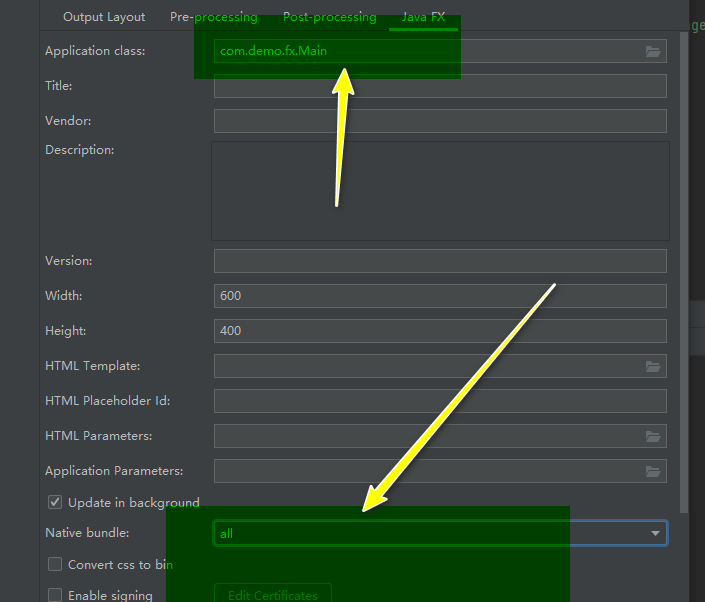
构建 Artifact
- 进入
Build->Build Artifacts。 - 选择你刚刚创建的 Artifact,然后点击
Build。
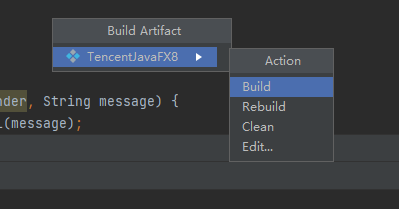
检查输出
构建完成后,检查指定的输出目录,你应该能看到生成的 exe 文件。
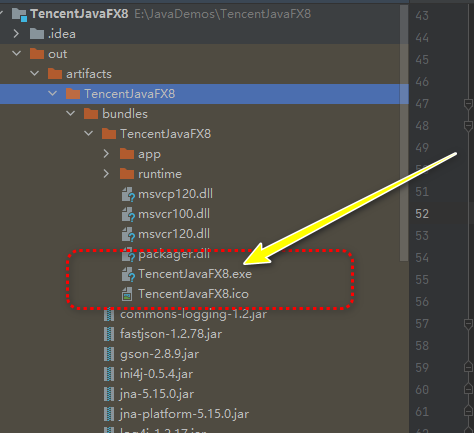
运行效果
最后,我们来看一下运行结果吧,现在谁有能说Java已死,大模型才是未来呢。

未来展望
伴随着 AI 模型的进一步发展以及桌面应用的需求增长,JavaFX 与混元大模型的结合将有着更广阔的应用前景。从智能化交互到自动化操作,未来的桌面应用将更加智能化、多样化,满足用户日益增长的需求。
将 JavaFX 与混元大模型结合,不仅能够为用户提供更智能、更高效的交互体验,还能显著提升桌面应用的功能与扩展性。在未来,更多智能应用场景的实现将离不开这样的技术组合。
原创声明:本文系作者授权腾讯云开发者社区发表,未经许可,不得转载。
如有侵权,请联系 cloudcommunity@tencent.com 删除。
原创声明:本文系作者授权腾讯云开发者社区发表,未经许可,不得转载。
如有侵权,请联系 cloudcommunity@tencent.com 删除。
评论
登录后参与评论
推荐阅读
目录

